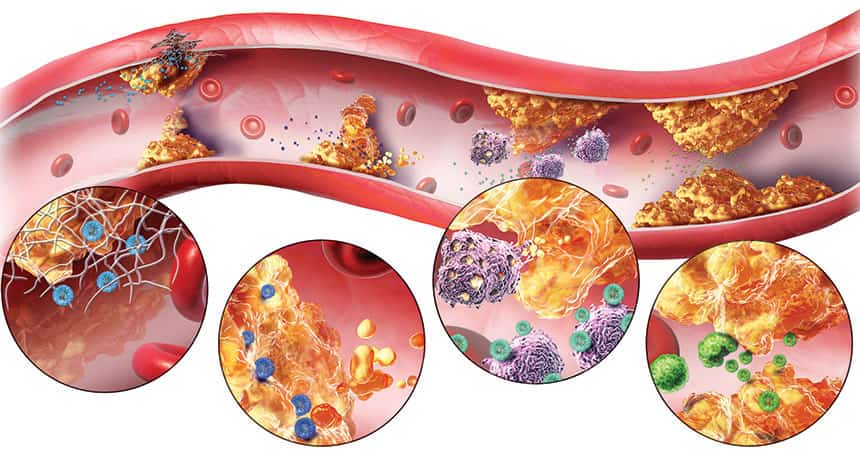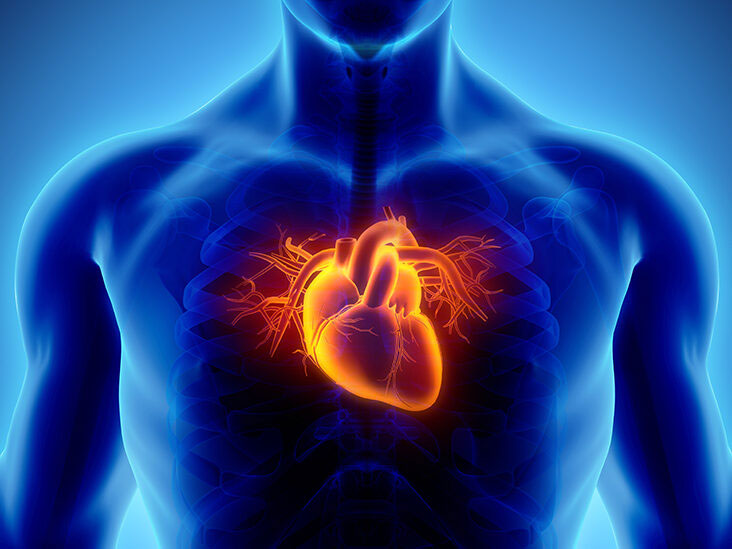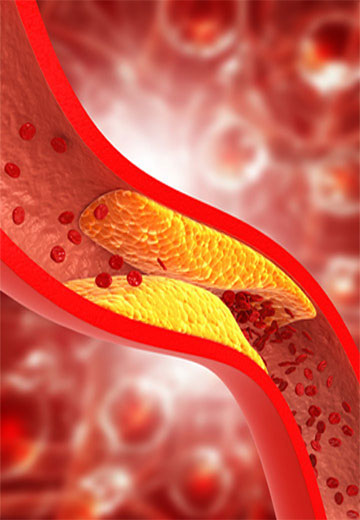ATHEROSCLEROSIS (ARTERIOSCLEROSIS)
Arteriosclerosis and atherosclerosis are sometimes used to mean the same thing, however, there is a difference between the two terms.
Arteriosclerosis happens when the blood vessels that carry oxygen and nutrients from your heart to the rest of your body (arteries) become thick and hard sometimes blocking blood flow to your organs and tissues. Healthy arteries are flexible and elastic, but over time, the walls in your arteries could harden, a condition commonly known as the hardening of the arteries.
Atherosclerosis is a certain type of arteriosclerosis.
Atherosclerosis is the accumulation of fats, cholesterol, and other substances in and on your artery walls. This build-up is known as plaque. The plaque could cause your arteries to narrow, restricting blood flow. The plaque could also burst, leading to a blood clot.
However, atherosclerosis is usually considered a heart problem, it could affect arteries anywhere in your body. Atherosclerosis could be treated. Healthy lifestyle habits could help prevent atherosclerosis.

ATHEROSCLEROSIS SYMPTOMS
Mild atherosclerosis generally does not have any symptoms.
You generally would not have atherosclerosis symptoms until an artery is so narrowed or clogged that it cannot supply enough blood to your organs and tissues. Sometimes a blood clot completely blocks blood flow, or even breaks apart and could trigger a heart attack or stroke.
Symptoms of moderate to severe atherosclerosis depend on which arteries are damaged. For instance:
- If you have atherosclerosis in your heart arteries, you might have symptoms, like chest pain or pressure (angina).
- If you have atherosclerosis in the arteries leading to your brain, you might have signs and symptoms like unexpected numbness or weakness in your arms or legs, trouble speaking or slurred speech, momentary loss of vision in one eye, or drooping muscles in your face. These signal a transient ischemic attack (TIA), which, if left untreated, might progress to a stroke.
- If you have atherosclerosis in the arteries in your arms and legs, you might have signs or symptoms of peripheral artery disease, like leg pain when walking (claudication) or decreased blood pressure in an affected limb.
- If you have atherosclerosis in the arteries leading to your kidneys, you will develop high blood pressure or kidney failure.
WHEN SHOULD YOU SEE A DOCTOR?
If you think you have atherosclerosis, talk to your doctor or primary care physician. Also pay attention to early symptoms of inadequate blood flow, like chest pain (angina), leg pain, or numbness.
Early diagnosis and treatment could stop atherosclerosis from worsening and prevent a heart attack, stroke, or another medical emergency.

ATHEROSCLEROSIS CAUSES
Atherosclerosis is a slow, progressive disease that might start as early as childhood. However the exact cause is unknown, atherosclerosis might start with damage or injury to the inner layer of an artery. The damage might be caused by:
- High blood pressure
- High cholesterol
- High triglycerides, a kind of fat (lipid) in your blood
- Smoking and other sources of tobacco
- Insulin resistance, obesity, or diabetes
- Inflammation from an unknown cause or from diseases like arthritis, lupus, psoriasis, or inflammatory bowel disease
Once the inner wall of an artery is damaged, blood cells and other substances usually clump at the injury area and build up in the inner lining of the artery.
Over time, fatty deposits (plaque) made of cholesterol and other cellular products also build up at the injury area and harden, narrowing your arteries. The organs and tissues connected to the blocked arteries then do not receive enough blood to function properly.
Ultimately, pieces of the fatty deposits might break off and enter your bloodstream.
In addition, the smooth lining of the plaque might rupture, spilling cholesterol and other substances into your bloodstream. This might cause a blood clot, which could block the blood flow to a certain part of your body like happens when blocked blood flow to your heart causes a heart attack. A blood clot could also travel to other parts of your body, blocking flow to another organ.
ATHEROSCLEROSIS RISK FACTORS
Hardening of the arteries happens over time. Besides aging, factors that might increase your risk of atherosclerosis include:
- High blood pressure
- High cholesterol
- High levels of C-reactive protein (CRP), a marker of inflammation
- Diabetes
- Obesity
- Sleep apnea
- Smoking and other tobacco use
- A family history of early heart disease
- Lack of exercise
- An unhealthy diet
ATHEROSCLEROSIS COMPLICATIONS
The complications of atherosclerosis depend on which arteries are obstructed. For instance:
- Coronary artery disease – When atherosclerosis narrows the arteries close to your heart, you might develop coronary artery disease, which could cause chest pain (angina), a heart attack, or heart failure.
- Carotid artery disease – When atherosclerosis narrows the arteries close to your brain, you might develop carotid artery disease, which could cause a transient ischemic attack (TIA) or stroke.
- Peripheral artery disease – When atherosclerosis narrows the arteries in your arms or legs, you might develop circulation problems in your arms and legs known as peripheral artery disease. This could make you less sensitive to heat and cold, increasing your risk of burns or frostbite. In rare cases, poor circulation in your arms or legs could cause tissue death (gangrene).
- Aneurysms –Atherosclerosis could also cause aneurysms, a severe complication that could happen anywhere in your body. An aneurysm is a protrusion in the wall of your artery.
- Most people with aneurysms do not have symptoms. Pain and throbbing in the region of an aneurysm might happen and is a medical emergency.
- If an aneurysm bursts, you might face life-threatening internal bleeding. However this is generally an unexpected, catastrophic event, a slow leak is possible. If a blood clot within an aneurysm dislodges, it might block an artery at some distant point.
- Chronic kidney disease – Atherosclerosis could cause the arteries leading to your kidneys to narrow, preventing oxygenated blood from reaching them. Over time, this could affect your kidney function, keeping waste from exiting your body.
ATHEROSCLEROSIS PREVENTION
The same healthy lifestyle changes suggested to treat atherosclerosis also help prevent it. These include:
- Quitting smoking
- Eating healthy foods
- Exercising regularly
- Maintaining a healthy weight
- Checking and maintaining a healthy blood pressure
- Checking and maintaining healthy cholesterol and glucose levels
Simply remember to make changes one step at a time, and keep in mind what lifestyle changes are manageable for you in the long run.
ATHEROSCLEROSIS DIAGNOSIS
Your doctor or primary care physician will perform a physical examination and ask questions about your personal and family health history. You might be referred to a doctor or primary care physician that specializes in heart diseases (cardiologist).
Your doctor or primary care physician might hear a whooshing sound (bruit) when listening to your arteries with a stethoscope.
Depending on the results of the physical examination, your doctor or primary care physician might recommend one or more tests, including:
- Blood tests – Your doctor or primary care physician will order blood tests to check your blood sugar and cholesterol levels. High levels of blood sugar and cholesterol increase your risk of atherosclerosis. A C-reactive protein (CRP) test also might be done to check for a protein linked to inflammation of the arteries.
- Electrocardiogram (ECG or EKG) – This easy and painless test records the electrical signals in your heart.
- Exercise stress test – If your signs and symptoms happen most usually during exercise, your doctor or primary care physician might recommend this test. You will walk on a treadmill or ride a stationary bike while you are connected to an electrocardiogram (ECG). Because exercise makes your heart pump harder and faster than it does during most daily activities, an exercise stress test could reveal problems within your heart that may otherwise be missed. If you are unable to exercise, you might be given a medication that mimics the effect of exercise on your heart.
- Echocardiogram – This test uses sound waves to show how well blood flows when the heart beats and through your arteries. At times it is combined with exercise stress testing.
- Doppler ultrasound – Your doctor or primary care physician might use a special ultrasound device (Doppler ultrasound) to measure your blood pressure at various points along your arm or leg. These measurements could help your doctor or primary care physician determine the degree of any blockages, as well as the speed of blood flow in your arteries.
- Ankle-brachial index (ABI) – This test could tell if you have atherosclerosis in the arteries in your legs and feet.
During an ankle-brachial index (ABI) test, your doctor or primary care physician compares the blood pressure in your ankle with the blood pressure in your arm. An abnormal difference might be a sign of peripheral vascular disease, which is generally caused by atherosclerosis. - Cardiac catheterization and angiogram – This test could show if your coronary arteries are narrowed or blocked.
During this procedure, a doctor or primary care physician inserts a thin, flexible tube (catheter) into a blood vessel and to your heart. The dye moves through the catheter. As the dye fills your arteries, the arteries become visible on X-ray, revealing regions of blockage. - Coronary calcium scan – Also known as a heart scan, this common test uses computerized tomography (CT) imaging to create detailed images of your heart. It could show calcium deposits in the artery walls. Results of the test are provided in the form of a score. When calcium is present, the higher the score, the higher your risk of heart illness.
- Other imaging tests – Your doctor or primary care physician might also use magnetic resonance angiography (MRA) or positron emission tomography (PET) to study your arteries. These tests could show hardening and narrowing of large arteries, as well as aneurysms.

ATHEROSCLEROSIS TREATMENT
Lifestyle changes, like eating a healthy diet and exercising, are the first treatment for atherosclerosis and might be all that you require to treat your atherosclerosis. But sometimes, medication or surgical procedures might be required.
Medications
Many different medicines are available to slow or even reverse the effects of atherosclerosis. Here are some drugs used to treat atherosclerosis:
- Statins and other cholesterol medications – Aggressively lowering your low-density lipoprotein (LDL) cholesterol the bad cholesterol could slow, stop or even reverse the build-up of fatty deposits in your arteries.
Statins are frequently prescribed to lower cholesterol, improve artery health, and prevent atherosclerosis. There are many other kinds of cholesterol-lowering medications. Another common type is a cholesterol absorption inhibitor known as ezetimibe (Zetia). You might require more than one type of cholesterol medication. - Blood thinners – Your doctor or primary care physician might prescribe blood-thinning medications, like aspirin, to lower your risk that platelets will clump in narrowed arteries, form a blood clot and cause further blockage.
- Blood pressure medications – Drugs to reduce blood pressure do not help reverse atherosclerosis but instead prevent or treat complications associated with the disease. For instance, specific blood pressure medications could help lower your risk of a heart attack.
- Other medications – Your doctor or primary care physician might prescribe other medications to control health conditions that increase your risk of atherosclerosis, like diabetes. And, certain medications to treat symptoms of atherosclerosis, like leg pain during exercise, might be prescribed.
Surgery or other procedures
Sometimes more aggressive treatment is required to treat atherosclerosis. If you have serious symptoms or a blockage, your doctor or primary care physician might recommend one of the following surgical procedures:
- Angioplasty and stent placement – This procedure also known as percutaneous coronary intervention (PCI) helps open a clogged or blocked artery. Your doctor or primary care physician inserts a catheter into the diseased artery. A second catheter with a deflated balloon on its tip is passed through the first catheter to the obstruction. Your doctor or primary care physician inflates the balloon, widening the artery. A mesh tube (stent) is generally left in the artery to help it open.
- Endarterectomy – Sometimes, plaque build-up must be surgically removed from the walls of a blocked artery. When the procedure is done on arteries in the neck (the carotid arteries), it is known as carotid endarterectomy.
- Fibrinolytic therapy – If you have an artery that is blocked by a blood clot, your doctor or primary care physician might use a clot-dissolving drug to break it apart.
- Coronary artery bypass surgery – During this type of open-heart surgery, your doctor or primary care physician takes a healthy blood vessel from another part of the body to create a bypass around the narrowed artery, redirecting blood flow. At times the bypass is a graft made of synthetic material.
If you or anyone you know is suffering from atherosclerosis, our expert providers at Specialty Care Clinics will take care of your health and help you recover.
Call (469) 545-9983 to book a telehealth appointment for an at-home check-up.
